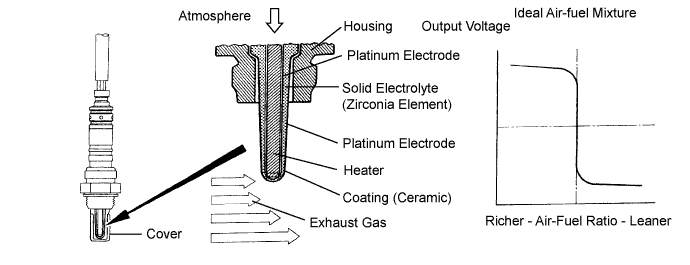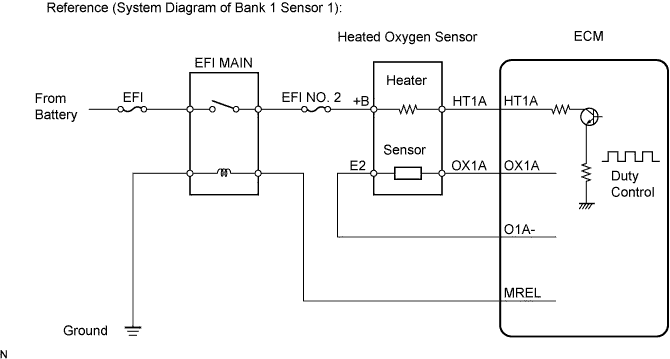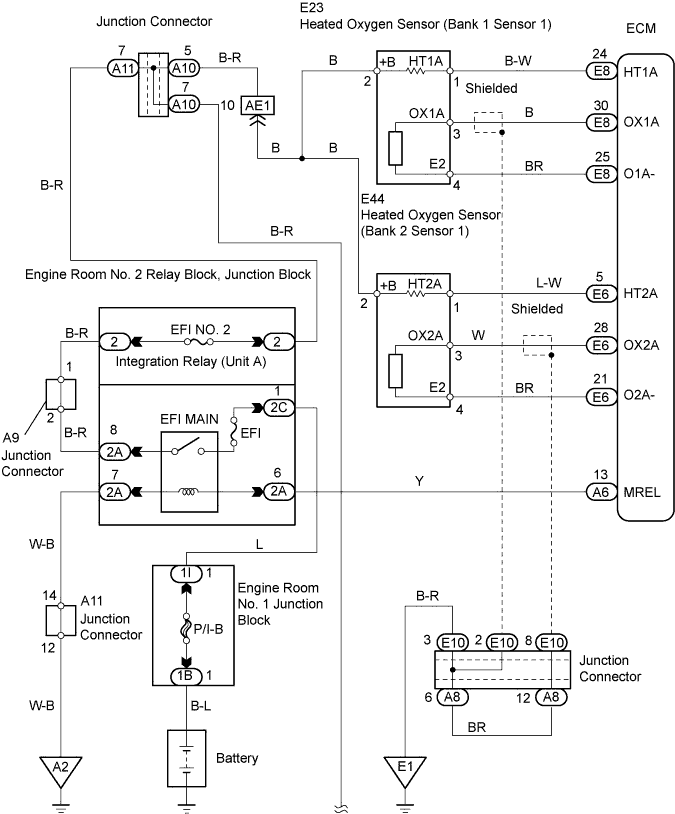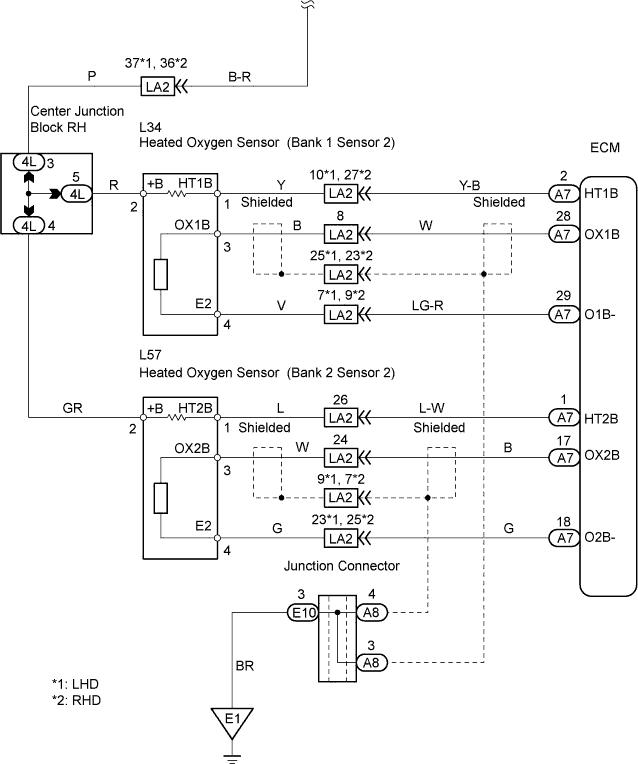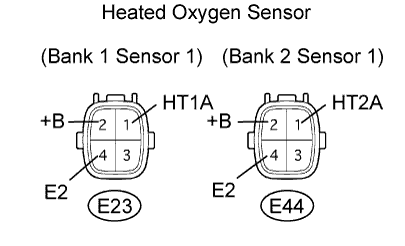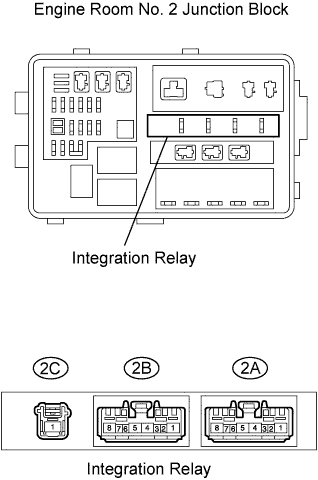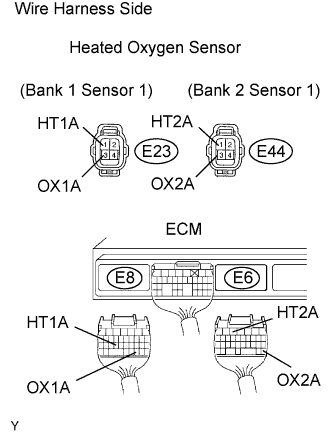Engine. Lexus Gs430, Gs300. Uzs190 Grs190
DESCRIPTION
MONITOR DESCRIPTION
WIRING DIAGRAM
CONFIRMATION DRIVING PATTERN
INSPECTION PROCEDURE
CHECK OTHER DTC OUTPUT
READ DATA LIST (HEATED OXYGEN SENSOR (SENSOR 1) VOLTAGE)
CHECK CONNECTION PCV HOSE
INSPECT HEATED OXYGEN SENSOR
INSPECT INTEGRATION RELAY (EFI MAIN)
CHECK WIRE HARNESS (HEATED OXYGEN SENSOR (SENSOR 1) - ECM)
CHECK AIR INDUCTION SYSTEM
CHECK FUEL PRESSURE
INSPECT FUEL INJECTOR
CHECK FOR EXHAUST GAS LEAKAGE
PERFORM CONFIRMATION DRIVING PATTERN
READ OUTPUT DTC (DTC P0134 OR P0154 IS OUTPUT AGAIN)
CONFIRM IF VEHICLE HAS RUN OUT OF FUEL
DTC P0134 Oxygen Sensor Circuit No Activity Detected (Bank 1 Sensor 1) |
DTC P0154 Oxygen Sensor Circuit No Activity Detected (Bank 2 Sensor 1) |
DESCRIPTION
The heated oxygen sensor is used to monitor oxygen concentration in the exhaust gas. For optimum catalytic converter operation, the air-fuel mixture must be maintained near the ideal stoichiometric air-fuel ratio. The heated oxygen sensor output voltage changes suddenly in the vicinity of the stoichiometric air-fuel ratio. The ECM adjusts the fuel injection time so that the air-fuel ratio is nearly stoichiometric. The heated oxygen sensor generates a voltage between 0.1 and 0.9 V in response to the oxygen concentration in the exhaust gas. If the oxygen concentration in the exhaust gas increases, the air-fuel ratio is called LEAN. The heated oxygen sensor voltage drops below 0.45 V, which informs the ECM of the LEAN condition.If oxygen is not in the exhaust gas, the air-fuel ratio is called RICH. The heated oxygen sensor voltage increases above 0.45 V, which informs the ECM of the RICH condition.- HINT:
- The ECM provides a pulse width modulated control circuit to adjust current through the heater. The heated oxygen sensor heater circuit uses a relay on the +B side of the circuit.
DTC No.
| DTC Detection Condition
| Trouble Area
|
P0134
P0154
| - After engine is warmed up, heated oxygen sensor (sensor 1) does not indicate RICH (greater than 0.45 V) even once when conditions (a), (b), (c), (d) and (e) continue for 20 seconds (1 trip detection logic):
- (a) Engine speed: 1,400 rpm or more
- (b) Vehicle speed: 40 km/h (25 mph) or more
- (c) Throttle valve is not fully closed
- (d) 180 seconds or more after starting engine
- (e) ECT is more than 40°C (104°F)
| - Open or short in heated oxygen sensor (sensor) circuit
- Heated oxygen sensor (sensor 1)
- PCV valve and hose
- Air induction system
- Fuel pressure
- Injector
- Gas leakage in exhaust system
- EFI MAIN relay
- ECM
|
- HINT:
- Confirm the heated oxygen sensor (sensor 1) voltage. Enter the following menus: Powertrain / Engine / Data List / Primary / O2S B1 S1 (or O2S B2 S1).
- If the voltage is less than 0.1 V, the sensor circuit may be open or short.
MONITOR DESCRIPTION
The ECM uses the heated oxygen sensor to optimize the air-fuel mixture with closed-loop fuel control. This control helps decrease exhaust emissions by providing the catalyst with a nearly stoichiometric mixture. The sensor detects the oxygen level in the exhaust gas and the ECM uses this data to control the air-fuel ratio. The sensor output voltage range is from 0.1 V to 0.9 V. If the signal voltage is less than 0.45 V, the air-fuel ratio is LEAN. If the signal voltage is more than 0.45 V, the air-fuel ratio is RICH. If the sensor does not indicate RICH at least once despite the conditions for the closed-loop fuel control being met and the specified time period has passed, the ECM will conclude that the closed-loop fuel control is malfunctioning. The ECM will illuminate the MIL and a DTC is set.
WIRING DIAGRAM
CONFIRMATION DRIVING PATTERN
- Connect the intelligent tester to the DLC3.
- Allow the engine to idle until ECT reaches 40°C (104°F).
- Allow the vehicle to run at 60 km/h (38 mph) or more for 3 minutes or more.
INSPECTION PROCEDURE
- HINT:
- It is possible the malfunctioning area can be found using the Active Test Control operation. The Active Test can determine if the heated oxygen sensor or other potential trouble areas are malfunctioning or not.
- The injection volume can be switched to -12.5% (decrease) or +25% (increase) by the Active Test.
- The Active Test procedure enables a technician to check and graph the output voltage of the heated oxygen sensors.
- Procedure:
- Connect the intelligent tester to the DLC3.
- Turn the engine switch on (IG).
- Warm up the engine by running the engine at 2,500 rpm for approximately 90 seconds.
- Enter the following menus: Powertrain / Engine / Active Test / Control the Injection Volume.
- Perform the Active Test while the engine is idling.
- Standard:
- The heated oxygen sensor reacts in accordance with the increase and decrease of injection volume:
+25% → RICH output: More than 0.55 V
-12.5% → LEAN output: Less than 0.4 V
- NOTICE:
- The heated oxygen sensor (sensor 1) output has a few seconds of delay and the heated oxygen sensor (sensor 2) output has a maximum of 20 seconds of delay.
- If the vehicle is short on fuel, the air-fuel ratio becomes LEAN and the DTCs will be recorded.
Case
| Heated Oxygen Sensor Voltage (sensor 1)
| Heated Oxygen Sensor Voltage (sensor 2)
| Main Suspected Trouble Area
|
1
| Injection Volume
+25%
-12.5%
| 
| Injection Volume
+25%
-12.5%
| 
| -
|
Heated Oxygen Sensor Voltage
0.55 V or more
Below 0.4 V
| 
| Heated Oxygen Sensor Voltage
0.5 V or more
Below 0.4 V
| 
|
2
| Injection Volume
+25%
-12.5%
| 
| Injection Volume
+25%
-12.5%
| 
| Heated oxygen sensor (sensor 1)
Heated oxygen sensor heater (sensor 1)
|
Heated Oxygen Sensor Voltage
Almost
no reaction
| 
| Heated Oxygen Sensor Voltage
0.5 V or more
Below 0.4 V
| 
|
3
| Injection Volume
+25%
-12.5%
| 
| Injection Volume
+25%
-12.5%
| 
| Heated oxygen sensor (sensor 2)
Heated oxygen sensor heater (sensor 2)
|
Heated Oxygen Sensor Voltage
0.55 V or more
Below 0.4 V
| 
| Heated Oxygen Sensor Voltage
Almost
no reaction
| 
|
4
| Injection Volume
+25%
-12.5%
| 
| Injection Volume
+25%
-12.5%
| 
| Injector fuel pressure, Exhaust gas leak, etc.
(air-fuel ratio is extremely LEAN or RICH)
|
Heated Oxygen Sensor Voltage
Almost
no reaction
| 
| Heated Oxygen Sensor Voltage
Almost
no reaction
| 
|
- HINT:
- Read freeze frame data using the intelligent tester. Freeze frame data records the engine conditions when a malfunction is detected. When troubleshooting, freeze frame data can help determine if the vehicle was running or stopped, if the engine was warmed up or not, if the air-fuel ratio was LEAN or RICH, and other data from the time the malfunction occurred.
- Bank 1 refers to the bank that includes cylinder No. 1.
- Bank 2 refers to the bank that does not include cylinder No. 1.
- Cylinder No. 1 is located in the front part of the engine, opposite the transmission.
- Sensor 1 refers to the sensor closest to the engine body.
Connect the intelligent tester to the DLC3.
Enter the following menus: Powertrain / Engine / DTC.
Read the DTCs.
- Result:
Display (DTC output)
| Proceed to
|
P0134 or P0154
| A
|
P0134 or P0154 and other DTCs
| B
|
| 2.READ DATA LIST (HEATED OXYGEN SENSOR (SENSOR 1) VOLTAGE) |
Connect the intelligent tester to the DLC3.
Enter the following menus: Powertrain / Engine / Data List / Primary / O2S B1 S1 (or O2S B2 S1).
Allow the engine to idle until the ECT reaches 40°C (104°F).
Quickly depress the accelerator pedal 3 times until the engine RPM reaches 4,000 rpm. Then, read the heated oxygen sensor (sensor 1) voltage.
- Standard voltage:
- The heated oxygen sensor (sensor 1) voltage is 0.45 V or more at least once.
| 3.CHECK CONNECTION PCV HOSE |
- OK:
- PCV hose is connected correctly and is not damaged.
| | REPAIR OR REPLACE PCV HOSE |
|
|
| 4.INSPECT HEATED OXYGEN SENSOR |
Disconnect the E23 and E44 sensor connectors.
Measure the resistance of the sensor.
- Standard resistance:
Tester Connection
| Specified Condition
|
1 (HT1A) - 2 (+B)
| 11 to 16 Ω
|
1 (HT2A) - 2 (+B)
| 11 to 16 Ω
|
1 (HT1A) - 4 (E2)
| 10 kΩ or higher
|
1 (HT2A) - 4 (E2)
| 10 kΩ or higher
|
| | REPLACE HEATED OXYGEN SENSOR |
|
|
| 5.INSPECT INTEGRATION RELAY (EFI MAIN) |
Remove the integration relay from the engine room No. 2 junction block.
Measure the resistance of the EFI MAIN relay.
- Standard resistance:
Terminal Connections
| Specified Condition
|
2A-8 - 2C-1
| 10 kΩ or higher
|
2A-8 - 2C-1
| Below 1 Ω
(when battery voltage is applied to terminals 2A-6 and 2A-7)
|
| | REPLACE INTEGRATION RELAY |
|
|
| 6.CHECK WIRE HARNESS (HEATED OXYGEN SENSOR (SENSOR 1) - ECM) |
Disconnect the E23 and E44 sensor connectors.
Disconnect the E6 and E8 ECM connectors.
Measure the resistance of the wire harness side connectors.
- Standard resistance:
Tester Connection
| Specified Condition
|
E23-1 (HT1A) - E8-24 (HT1A)
| Below 1 Ω
|
E23-3 (OX1A) - E8-30 (OX1A)
| Below 1 Ω
|
E44-1 (HT2A) - E6-5 (HT2A)
| Below 1 Ω
|
E44-3 (OX2A) - E6-28 (OX2A)
| Below 1 Ω
|
E23-1 (HT1A) or E8-24 (HT1A) - Body ground
| 10 kΩ or higher
|
E23-3 (OX1A) or E8-30 (OX1A) - Body ground
| 10 kΩ or higher
|
E44-1 (HT2A) or E6-5 (HT2A) - Body ground
| 10 kΩ or higher
|
E44-3 (OX2A) or E6-28 (OX2A) - Body ground
| 10 kΩ or higher
|
| | REPAIR OR REPLACE HARNESS AND CONNECTOR |
|
|
| 7.CHECK AIR INDUCTION SYSTEM |
Check the air induction system for vacuum leaks.
- OK:
- There are no vacuum leaks in air induction system.
| | REPAIR OR REPLACE AIR INDUCTION SYSTEM |
|
|
Check the fuel pressure (Click here).
| | REPAIR OR REPLACE FUEL SYSTEM |
|
|
Check the injector injection (whether fuel volume is high or low, and whether injection pattern is poor).
| 10.CHECK FOR EXHAUST GAS LEAKAGE |
- OK:
- No gas leakage.
| | REPAIR OR REPLACE EXHAUST SYSTEM |
|
|
| OK |
|
|
|
| REPLACE HEATED OXYGEN SENSOR |
|
| 11.PERFORM CONFIRMATION DRIVING PATTERN |
- HINT:
- Clear all DTCs before performing the confirmation driving pattern.
| 12.READ OUTPUT DTC (DTC P0134 OR P0154 IS OUTPUT AGAIN) |
Clear the DTC (Click here).
Start the engine and allow the engine to idle for 15 seconds or more.
Read the DTC.
- Result:
Display (DTC output)
| Proceed to
|
None
| A
|
P0134 or P0154
| B
|
| 13.CONFIRM IF VEHICLE HAS RUN OUT OF FUEL |
If the vehicle has run out of fuel, proceed to A.
If the vehicle has not run out of fuel, proceed to B.
| | CHECK FOR INTERMITTENT PROBLEMS |
|
|
| A |
|
|
|
| DTC IS CAUSED BY RUNNING OUT OF FUEL |
|
